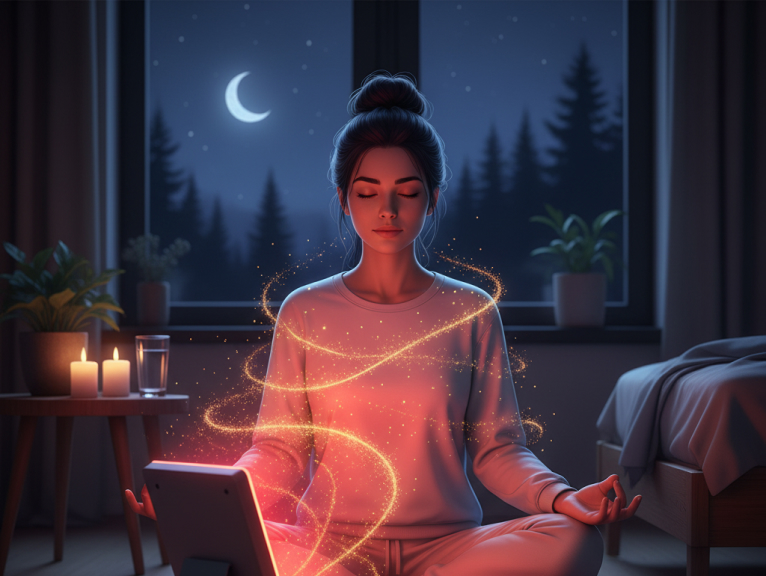
20 Years of Producing the Highest Quality, Most Reliable, and Effective LED mask.
bedtime routine, LED light therapy, sleep quality, circadian rhythm, red light therapy, sleep tips, meditation, yoga, sleep improvement, wind-down routine, better sleep

Sleep is not just rest—it’s essential for recovery, energy, cognitive function, mood regulation, immune health, and overall wellness. Without quality sleep, we risk chronic fatigue, lowered productivity, mood swings, weakened immunity, and even long-term health issues. Many people find falling asleep difficult or waking up tired, especially with modern stressors: late-night screen time, erratic schedules, anxiety, ambient light, etc.
One of the most effective ways to improve sleep quality is to develop a consistent bedtime ritual—a sequence of calming activities that signal to your body it’s time to wind down. For our team, wind-down routines often include reading, light stretching, journaling, dim lighting, and importantly, LED light therapy (particularly red or near-infrared light). When done correctly, this blend of behavioral cues + light modulation can help shift the circadian rhythm, enhance melatonin production, reduce stress hormones, and improve overall sleep quality.
In this article, we’ll dive into the science of how light affects sleep, detail our team’s favorite wind-down practices, provide actionable routines incorporating LED light therapy, and answer frequently asked questions to guide you safely and effectively into better rest.
Our sleep-wake cycles are regulated by an internal clock located in the suprachiasmatic nucleus (SCN) of the brain, which responds to light signals through the eyes. When exposed to bright or blue-enriched light (especially in the evening), melatonin production is suppressed and cortisol remains elevated, making it harder to fall asleep. On the other hand, dim, warm, red, or near-infrared light in the pre-sleep period signals the body that it’s time to wind down.
Studies at institutions like Harvard Health reveal that blue light from screens significantly disrupts melatonin release. Meanwhile, research into red light therapy suggests that exposure to specific red (≈ 630‑670 nm) or near-infrared wavelengths before bed can promote melatonin secretion, support deeper sleep, and improve sleep onset. Some small clinical trials show participants using red light therapy nightly reported shorter time to fall asleep, fewer awakenings, and improved restful sleep.
From interviews and internal feedback, here are some of the most-loved practices our team uses to prepare for sleep. These aren’t rigid rules—think of them as a menu to try from.
To magnify the benefits of your wind‑down ritual, the environment matters.
While bedtime routines are powerful, many people face hurdles. Here are tips to overcome them:
Here are common questions readers often ask, with evidence‑based answers:
1. Will using LED red light before bed actually help me fall asleep faster?
Yes—studies have shown red/NIR light used in evening reduce sleep onset latency. But results vary; pairing with dim lighting and avoiding blue light improves effects.
2. Does LED light therapy interfere with melatonin production?
Properly selected red or NIR light (warm, low intensity) does not suppress melatonin—unlike blue or bright white lights.
3. Do I need to wear goggles or close my eyes during a session?
Most LED devices are safe to use without covering eyes, but covering eyes or using protective goggles can help with comfort, especially if you are sensitive.
4. Can RLT improve vision or treat eye diseases?
There is preliminary evidence suggesting RLT can enhance retinal function and potentially help with age-related conditions, but it’s not a substitute for clinical treatments.
5. How often should I do LED light therapy for sleep improvement?
For many, nightly or near‑nightly use works best. If not possible, aim for at least 3–5 times a week. Consistency over frequency.
6. What if I still wake up at night or can’t stay asleep?
Check for factors: room noise, temperature, caffeine/alcohol intake, stress. Your routine may need adjustments in environment or timing.
7. Are there risks for people with eye disease (e.g. glaucoma, retinal degeneration)?
There is limited data. If you have existing eye conditions, consult your optometrist/ophthalmologist before using LED over or near eyes.
8. Can LED light therapy replace sleeping pills or medications?
No. Light therapy is complementary—it supports natural sleep patterns but is not a substitute for prescribed treatment.
Everyone’s sleep needs are unique, but there’s a consistent pattern: slower pace, dim light, calming habits + targeted red/NIR LED exposure before bed can significantly improve how fast you fall asleep, how deeply you sleep, and how rested you wake up.
If you're ready to explore:
Sweet dreams start with the rituals we build—and the light we allow into our evening. Rest well.
